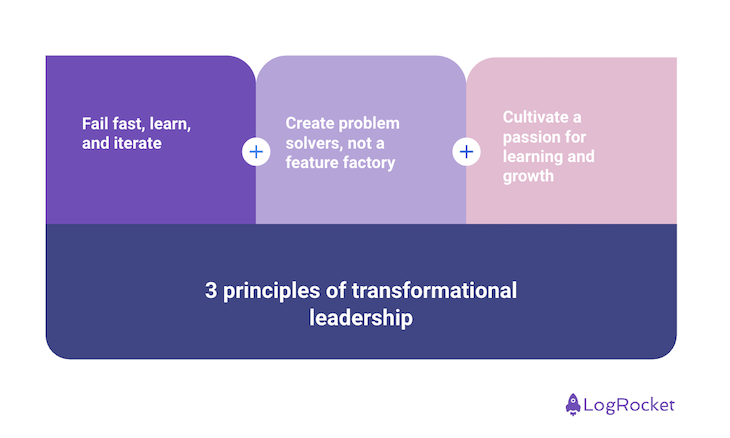In today’s fast-paced world, businesses need leaders that can transform and empower people to envision and unlock unprecedented opportunities. Successful leaders lean on a leadership style that allows them to be the most effective. Some of the popular leadership styles include: tactical leadership, transactional leadership, democratic leadership, autocratic leadership, servant leadership, and transformational leadership.

Most good leaders utilize a combination of leadership styles that they apply to relevant situations. However, leaders always have a dominant style that they’re recognized by.
In this article, you will learn what transformational leadership is, the components that go into it, and how you can influence your team by adopting it.
Transformational leadership centers on inspiring and motivating people to achieve a definitive, positive change that solves a bigger problem.
As the leader, you empower people by fostering a culture of creativity and innovation and promoting loyalty, trust, and respect.
Product management requires creative thinking, lightning-fast idea execution, adaptability, self-motivation, and a driven attitude.
In such a high-performing, high-velocity environment, leaders play a crucial role in creating a culture and atmosphere that encourages people to be and give their best.The team cannot perform at their best if they fear failure or experimentation. At the same time, you need to avoid costly blunders.
There’s a delicate balance between encouraging failure and maintaining a stable market value.
There are four primary components of transformational leadership:
To explain the traits of transformational leadership in product management, let’s take an example of a well-known leader, Elon Musk.
Although Elon Musk demonstrates mixed leadership styles like autocratic, transactional, and transformational leadership, we will focus on his transformational leadership style.
Elon Musk is a visionary who tries to achieve the unimaginable — whether to have a colony on Mars and make the human species’ existence multi-planetary or have an underground hyperloop that can travel 600 miles per hour. He believes in an idea, has a vision, and creates a team around him who also believes in the concept’s impact.
He encourages people to think creatively, work autonomously, and take full responsibility for their deliveries. When people see Musk’s vision coming to life, they get inspired to tackle world problems with the same enthusiasm. That’s the impact of a transformational leader.
One of the famous quotes from Elon Musk that describes his transformational leadership style is:
“People work better when they know what the goal is and why. It is important that people look forward to coming to work in the morning and enjoy working.”
In product management, if you want to build and create something beyond expectations, you need a leader who can envision the goal and inspire people to believe it’s possible. In the concept phase, there will be a lot of criticism, hesitation, and negative comments. Still, to push through the initial stage and create something extraordinary, the team needs a leader who believes in their potential and the concept itself.
When an organization is under a leader with a dominant transformational leadership style, the environment supports innovation and creativity resulting in cutting-edge technology inventions and breakthroughs. Transformational leaders cultivate the following three principles:

Failure is a setback — there’s no way to sugarcoat it. But when a product team fails in one iteration, guide the team to focus on learnings instead of dwelling on the negatives. Use the failure as a motivation to improve in the next iteration.
Re-evaluate and identify mistakes to undo and achieve the desired results instead. This mindset shift can only happen when the team knows how to take ownership and pivot away from setbacks. The product teams should feel confident that they won’t be held personally responsible for failures and have the willingness to own their mistakes and iterate them in the best possible way.
Returning to the Musk example, when the first spaceship Falcon One crashed, it was devastating for the entire company. At that moment, Musk chose to give a motivating speech that reminded people of their mission and how vital their end goal was. He also insisted that they wouldn’t give up despite this setback, shifting the feeling of despair and defeat to determination and destigmatizing the shame of failure, creating a safe environment to discuss the importance of failure for progress.
If your team only focuses on deliveries, as soon as an issue arises, it will shut everything down. You need every team member to be self-driven and good at problem-solving so they can stay focused. Encouraging each team member to learn and grow, be self-motivated to solve problems, and find solutions will keep progress moving forward without requiring constant interference from product managers.
When developing products, there will be problems at all levels, and every individual needs to pitch in and contribute to the solution.
When an individual has an idea for solving a problem, they get obsessed with their vision and cannot see any faults. People often become defensive when someone tries to contribute to the concept with some improvement suggestions. This can be a dangerous and harmful mindset when working on a bigger problem.
An open-minded passion for learning and growing helps to avoid this blinding pitfall. A transformational leader understands the importance of learning and growing, provides opportunity and time, and elevates the importance of learning to his team.
In product management, people often fall into the cycle of delivering one feature after another, leaving no time for reflection or learning about the value of the product. When this cycle continues for a more extended period, the product team ultimately loses focus on the big picture and does not feel like a part of the vision.
Different types of product managers need different skill sets to succeed in their roles, but every product manager needs these five essential traits to be successful with their teams:
Although transformation and transactional leadership styles are different, it doesn’t mean one of them is good or bad. Both leadership styles are incredibly efficient if applied in the right situation; hence, good leaders understand how to integrate both techniques.
The transactional leadership style follows the principle of goals and rewards. People under transactional work towards a specific target and receive a reward upon attaining it. It’s a highly effective leadership style when the organization seeks to maximize productivity to achieve targets and without innovation.
To understand these two leadership styles, let’s examine how they are applied in some aspects:
| Aspects | Transactional leadership | Transformational leadership |
| Primary focus | Target achievement, routine & discipline | Vision alignment, inspiration, positive impact |
| Communication base | Clear directions, set targets, short term objectives | Emphasis on value and inspiration through bigger picture |
| Motivating factor | Rewards for achievements | Positive contribution towards the goal |
| Working environment | Build authoritative hierarchy and decision structure | Builds a culture for autonomy, ownership and self-driven teams |
| Leadership approach | Being charismatic and visionary, building trust and loyalty | Being pragmatic and performance focused, increasing efficiency and output |
Effective leadership is the backbone of every organization. Based on the organization’s needs and current situation, good leaders adapt and combine leadership styles and behavior. Today’s fast-changing environment demands technological advancement and innovation to stay relevant. Simultaneously the need for adaptability and constant change requires leadership that inspires and motivates people to create positive change.
Transformational leadership’s focus on anchoring the vision with the team, creating an opportunity for innovation, empowering people to take ownership, and providing prospects for personal growth aligns perfectly with the demands of product management. Product teams need the circumstance, motivation, and mindset to build breakthrough products.
Product managers can inspire and motivate their teams to work towards a common goal by having a vision and strong communication skills.
Featured image source: IconScout

LogRocket identifies friction points in the user experience so you can make informed decisions about product and design changes that must happen to hit your goals.
With LogRocket, you can understand the scope of the issues affecting your product and prioritize the changes that need to be made. LogRocket simplifies workflows by allowing Engineering, Product, UX, and Design teams to work from the same data as you, eliminating any confusion about what needs to be done.
Get your teams on the same page — try LogRocket today.

Most teams fail at autonomy. Learn how clear rules help product teams move faster without micromanagement.

A practical framework for PMs to use AI in ideation without sacrificing judgment, strategy, or decision quality.

A practical five minute revenue estimation method to help product managers compare ideas, drop low impact features, and prioritize smarter.

A practical guide for PMs who want to stop being bottlenecks, delegate smarter, and lead teams effectively with a clear ownership framework.